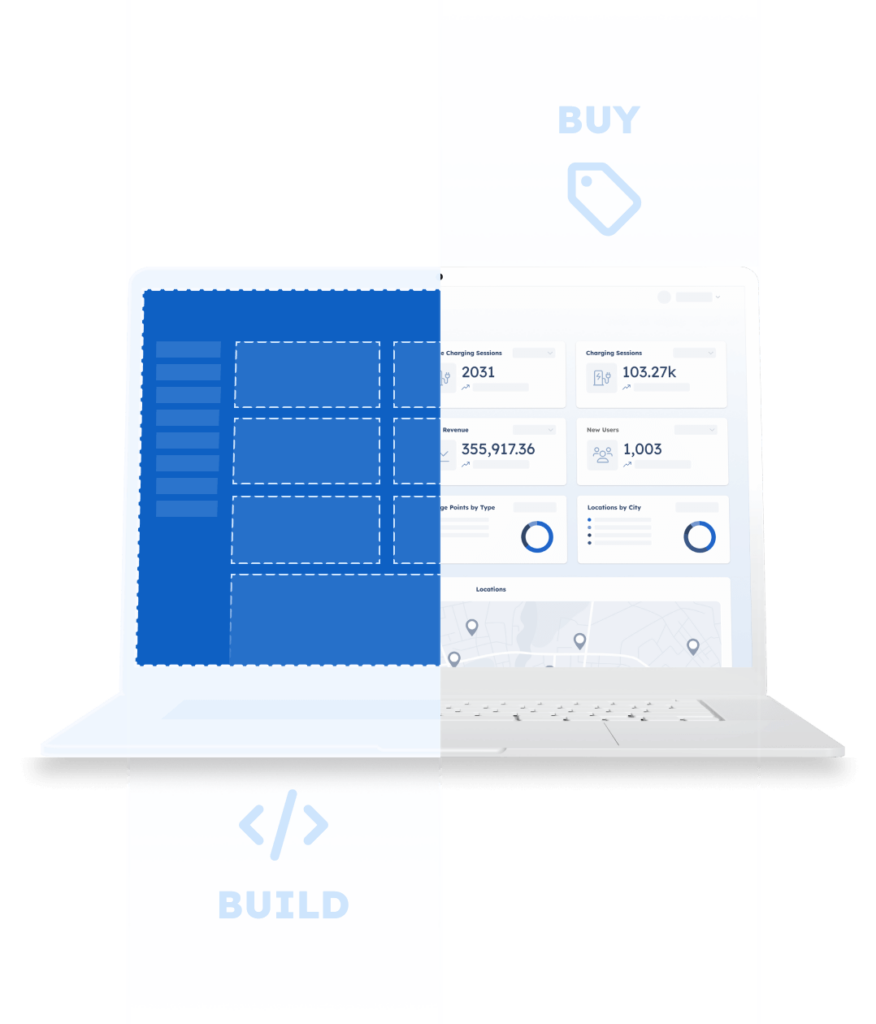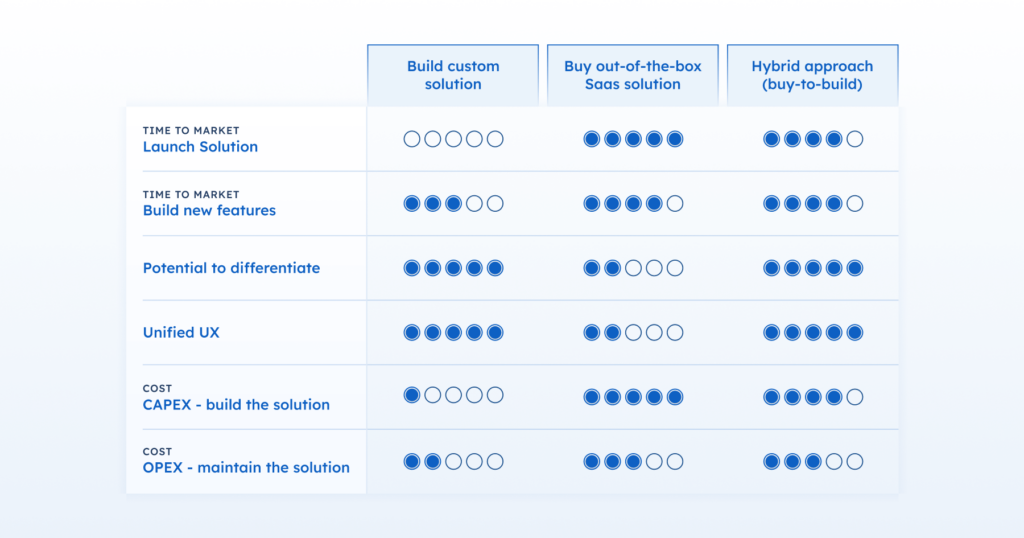The dilemma
The decision between building or buying EV charging management software is a significant crossroad for key industry players. The choice fundamentally revolves around whether to invest in costly and time-intensive resources to develop a solution that offers customization and differentiation or buy a ready-made solution that is more cost-effective but might constrain competitive edge and scalability. Amidst the conventional build vs buy decision, a third, innovative option emerges: the hybrid approach. This strategy enables companies to pay for an existing solution and then customize it to meet their specific requirements.
The choice standing before CPOs isn’t between building or buying but selecting a path that offers the best of both worlds – a solid foundation with the room to innovate and differentiate in a competitive market.

Who struggles with this decision?
Energy companies, fuel retailers, and enterprises eager to strategically position themselves in the growing EV charging sector must navigate this choice carefully. They face the complex challenges of managing thousands of chargers across diverse geographical regions, serving multiple charging scenarios, and enhancing their existing services and user base.
These companies have established software ecosystems that include CRM, ERP, and billing systems requiring seamless integration with new EV charging solutions. Their experienced teams of project managers, product specialists, designers, and developers are skilled in crafting and maintaining complex systems. Such internal expertise and infrastructure might incline them to favor in-house development, leveraging their substantial financial resources to either build from scratch in-house or acquire a company with an existing solution.
The main criteria to consider before making a decision
To make a well-informed decision between buying, building, or opting for a hybrid solution in your EV charging management software, you should carefully assess each option against four key criteria. This evaluation will help determine the best path forward, aligning with strategic goals and operational requirements.
Here’s a detailed look at the four main decision criteria:

Time to market
There are two perspectives to consider under this criterion:
Time to launch services: Quick market entry can secure advantageous locations and establish valuable partnerships. The difference between a 2-month versus an 18-month launch timeline can significantly impact market standing and partnership opportunities.
Time to develop new features: Staying ahead of evolving regulations and market requirements demands quick adaptation. Delays in updating or improving features can result in missed opportunities and revenue loss.Potential to differentiate

Potential to differentiate
Companies must offer unique value propositions to stand out, build brand recognition, and foster customer loyalty. Differentiation is essential for capturing market share and establishing a strong brand through innovative features, superior user experience, or other unique selling points.

Unified user experience (UX)
For energy companies, fuel retailers, or enterprise companies with existing customer interfaces, integrating EV charging services without disrupting the user experience is crucial. Whether through an app or a web portal, the integration of EV charging solutions should enhance, not complicate, the existing user journey.

Cost (CAPEX/OPEX)
There are two perspectives to consider under this criterion:
Capital expenditure (CAPEX): Capex refers to the costs involved in building or acquiring the solutions, which may vary. Building your solution typically has higher initial costs for development, whereas purchasing or licensing may involve significant acquisition costs or recurring payments.
Operational expenditure (OPEX): Long-term operational and maintenance costs are equally pivotal and can rise with business growth, more chargers, higher transactions, and an expanding user base.

(Source: EY)
Let’s explore the three options – build, buy, and hybrid – by examining them across these four criteria.
The build options
The build option refers to developing a custom EV charging management software from the ground up. This approach allows companies to tailor the software’s functionality, user interface, and integrations entirely to their specific requirements, offering maximum customization and differentiation potential.

Time to market
One of the main weaknesses of this option. Building a custom software solution can be a significant time investment, often requiring 18-30 months to reach the market readiness of existing solutions. This extended timeline can be a critical disadvantage in the fast-paced EV charging sector.

Potential to differentiate
This is the main strength of this option. Custom development is a powerful tool for differentiation. Companies can offer distinctive value by creating unique user interfaces, features, or workflows that help them win, engage, and retain customers and partners. Companies can explore new business models, innovate how they create value for their customers, and ultimately – become leaders in the industry.

Unified user experience (UX)
Developing your EV charging solution in-house by the team that has already created or implemented the rest of the existing company software stack ensures seamless integration with existing software systems, enhancing data utilization and user experience. This integration can streamline various business processes, like invoicing and billing, providing a cohesive and efficient customer journey.

Cost (CAPEX/OPEX)
Capital expenditure (CAPEX): The highest of the three options—build, buy, and buy to build—for your software is attributed to the extensive resources required in assembling a skilled development team. This intensive initial investment in human capital and development infrastructure elevates the CAPEX significantly above the other options, and these expenses could constitute a major portion of your business’s overall expenses.
Operational expenditure (OPEX): Although the upfront costs are higher, in the long term, the operational costs for your software are expected to decrease as the business scales. The scalable nature of software means that the costs do not necessarily increase in direct proportion to the number of chargers deployed. Hence, while the initial investment will vary significantly where you are deploying 100 chargers or 10,000 chargers, your software’s operational expenditure will become increasingly cost-effective on a per-charger basis, offering a better return on investment compared to other options.
AMPECO’S INSIGHT
In the complex realm of EV charging, focusing on innovation is more strategic than playing catch-up by building basic functionalities already available in the market. We suggest leveraging a development team to create unique and innovative features or interfaces that can truly differentiate your service, pushing your company to the forefront of the industry as an innovator, not just a follower.
The buy option
The buy option refers to acquiring off-the-shelf SaaS EV charging management solutions. These solutions have a predefined set of features and capabilities that you use as they come. You have very limited, if any, customization options, integrations, and API access.

Time to market
This is a key strength of the buy approach. Companies can quickly launch operations, significantly accelerating time to revenue which might be critical for some players. Initial setup typically takes several weeks to a few months and involves basic system configuration and branding to get the solutions up and running.

Potential to differentiate
Beyond basic branding through white-label mobile apps, there is minimal scope for differentiation. Companies are largely confined to the same feature set as any other user of the solution, limiting the opportunity to create unique value propositions.

Unified user experience (UX)
The generally limited API capabilities of off-the-shelf solutions, which usually enable only basic data transfer, constrain the ability to offer a cohesive user experience across different software platforms.

Cost (CAPEX/OPEX)
Capital expenditure (CAPEX): This is the other main strength of this option, as buying software generally involves the lowest initial investment, making it an attractive option for new market entrants.
Operational expenditure (OPEX): The typical transaction-based fees mean costs will grow with your business, potentially consuming a significant portion of your margins.
AMPECO’S INSIGHT
Not all “buy” options are equal. For CPOs, selecting the right one requires understanding their short- and long-term business objectives and the differences among software providers.
The “buy” option can be better suited to CPOs at the start of their journey or with simpler business models and customization requirements. It enables them to quickly enter the market, cultivate a customer base, initiate revenue streams, and gain hands-on market experience.
The hybrid option (Buy-to-build)
The hybrid option in EV charging management software combines the best of both worlds: it offers a comprehensive, ready-to-use platform, including a branded back office and EV driver mobile apps, while also allowing for customization and extension. You can add unique features, custom-built interfaces and integrate with other systems as needed.
This is where AMPECO’s platform excels, offering a beneficial option for companies that require a reliable, battle-tested platform but also foresee the need for specific customizations to differentiate in the market. This approach strikes a balance, offering a middle ground that caters to a wide range of business needs and growth stages.

Time to market
This approach helps you balance immediate business needs with long-term growth. Platform providers that embrace this option offer a comprehensive set of features to launch your business efficiently while also providing the flexibility to customize and expand as your needs grow.
Leveraging the provider’s experience across different clients and regions can accelerate your market entry, reduce operational complexities, and minimize risks, enabling you to focus on your core business strengths.

Potential to differentiate
With the hybrid approach, you can customize your mobile app’s user experience, integrate with your business’s existing systems or third-party services, and build tailored functionality that fits your business needs. This way, whether you’re serving public, residential, or fleet charging, you can meet specific customer needs. Combining this ability to customize with the reliability of an established EV charging platform gives your business a strong position across diverse market segments.

Unified user experience (UX)
Leveraging the hybrid approach through APIs, companies can create custom user interfaces and mobile apps that offer a cohesive and brand-aligned experience for EV drivers. It empowers companies to introduce EV charging services into their service portfolio and enhance customer engagement by seamlessly incorporating EV charging solutions into established workflows like invoicing, billing, and user management.

Cost (CAPEX/OPEX)
Capital Expenditure (CAPEX): As the company stabilizes in the market and identifies its specific needs, it can reallocate resources more strategically toward additional customizations or creating unique features, efficiently spreading out these costs. This approach not only aligns with its drive for efficiency and innovation but also serves as a vital cost optimization strategy for large-scale operators. Given their significant investments in hardware and site locations, optimizing software development costs frees up resources, enhancing their ability to invest in other areas critical for distinguishing their services and achieving market excellence.
Operational Expenditure (OPEX): Ongoing costs are typically structured around fixed monthly fees plus additional charges that vary with the scale of the operation, such as the number of active chargers or connectors. This pricing model helps in financial forecasting, as expenses align directly with network expansion, offering a transparent and predictable cost structure that grows in proportion to the business.
Leverage the Hybrid approach with AMPECO
At AMPECO, we recognize that creating a custom solution from scratch would be the optimal choice in an ideal world. However, given the constraints of time, budget, expertise, and the practical aspects of business, a more realistic approach is required.
The EV charging industry’s complexity and fast-paced nature, combined with the specialized skills required for software development, are precisely why we advocate for the hybrid approach.
Our white-label platform covers all of the functionalities CPOs require right out of the box, while the rest can be customized through the AMPECO API. It enables the design of unique user experiences, seamless integration with third-party or existing systems, and the development of distinctive selling points. Our Developer Hub provides all the tools and information you need to fully leverage our technology.
Our hybrid approach combines the reliability of a proven SaaS platform with the agility of API-enabled customization. By choosing this approach, you’re not just acquiring a static platform but one that is supported by a specialized development team committed to continuous innovation, ensuring the platform remains at the forefront of technological advancements, aligns with the latest market trends, and complies with recent regulations. Through API integrations, you can extend the platform’s capabilities and create custom functionalities that cater to your unique requirements.
Why we lead the way
AMPECO leads with a commitment to software superiority and innovation, maintaining the highest standards while giving you control over crucial business elements like roaming contracts, billing, payment processing, and user data.
Keep in mind that with AMPECO, you have the choice to integrate only the necessary components into your existing setup or migrate your entire operation to the AMPECO platform.
With a track record of empowering over 150 clients in 50 markets worldwide, AMPECO brings a wealth of experience, a dedicated team, and expert knowledge to guide you through the intricacies of the EV charging sector.
In conclusion, the choice standing before CPOs isn’t between building or buying but selecting a path that offers the best of both worlds – a solid foundation with the room to innovate and differentiate in a competitive market.
Embrace AMPECO’s hybrid approach that offers the best of both worlds—comprehensive ready-to-use functionalities and the freedom to customize and innovate.






